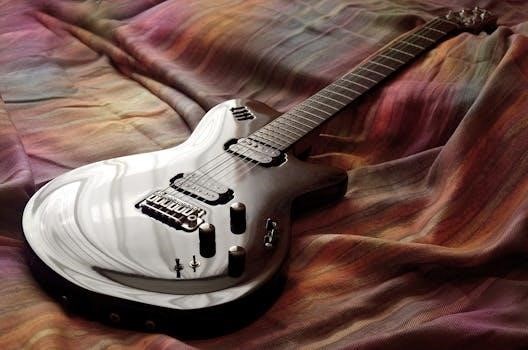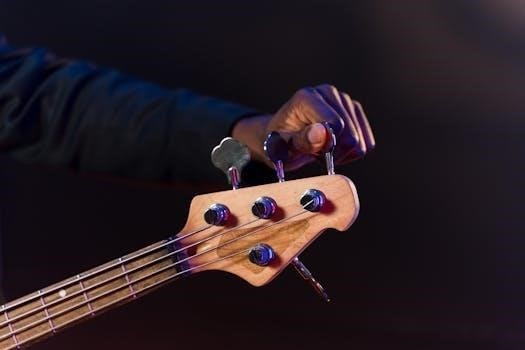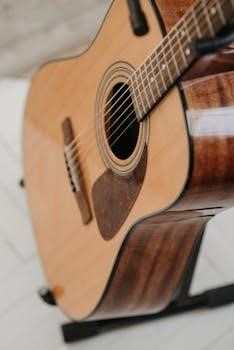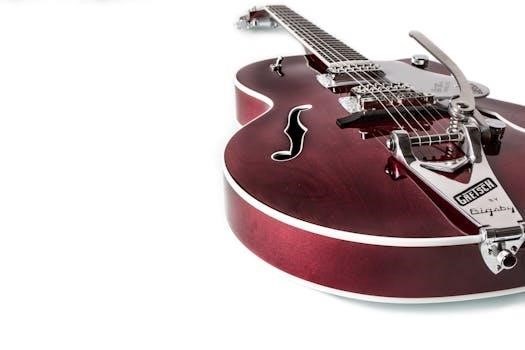Guitar fretboard diagrams are visual representations of the guitar neck, showing the position of notes. These diagrams aid in understanding note placement and are essential tools for learning scales and chords. They are found in various formats, including printable PDFs.
What is a Guitar Fretboard Diagram?
A guitar fretboard diagram is a schematic representation of the guitar’s neck, typically showing the strings and frets. It serves as a visual aid for guitarists to understand the location of notes, chords, and scales. These diagrams can be found in various formats, including printable PDFs, and are essential for learning and visualizing the instrument’s layout. They often include markings for specific notes or chord shapes, helping musicians to quickly identify patterns and finger positions. The use of fretboard diagrams significantly enhances the learning process for guitar players of all levels. They are a core tool for music instruction.
Understanding Fretboard Layout
Understanding the layout of a guitar fretboard involves grasping the standard tuning and how notes are positioned along the strings and frets. This knowledge is crucial for using fretboard diagrams effectively.
Standard Guitar Tuning
Standard guitar tuning, from the thickest to thinnest string, is E-A-D-G-B-E. This tuning is fundamental to understanding fretboard diagrams. The intervals between the strings are mostly perfect fourths, except for a major third between the G and B strings. Knowing this pattern makes it easier to locate notes and visualize scales and chords on the fretboard. Many diagrams are based around this tuning, and understanding it is crucial for using any diagram effectively. Some players may use alternate tunings, but standard tuning is the most common starting point for learning the guitar.
Note Placement on the Fretboard
Understanding note placement on the fretboard is key to using diagrams effectively. Each fret represents a half-step increase in pitch. Notes repeat in octave patterns up the neck, with the 12th fret marking an octave higher than the open string. Knowing the natural notes and how sharps and flats fit in helps navigate the fretboard. Fretboard diagrams often show these notes, either labeled or implied. Learning this layout provides a foundation for understanding scales, chords, and improvisation. Memorizing the note names and their positions makes playing more intuitive.

Types of Fretboard Diagrams
Fretboard diagrams come in different forms. There are blank diagrams for personal annotation, and labeled diagrams that show note names. Both are useful for learning and practice on guitar.
Blank Fretboard Diagrams
Blank fretboard diagrams are essential tools for guitarists, providing a clean slate to map out scales, chords, and melodies. These diagrams, often available as printable PDFs, allow users to create their own shapes, patterns, and exercises; The light design ensures that any markings made are clearly visible. Guitarists can utilize them to memorize notes, intervals, and develop a deep understanding of the fretboard. Blank diagrams also facilitate visual learning and are a valuable aid in improvisation and composition. They are a flexible resource for guitarists of all levels.
Labeled Fretboard Diagrams
Labeled fretboard diagrams are invaluable resources for guitarists seeking to understand the note layout on the guitar neck. These diagrams clearly display the names of each note at every fret position, making it easier to learn and memorize the fretboard. Often available in PDF format, they can be printed for easy reference. Some diagrams also highlight octave notes. They are essential for visualizing scales, chords, and intervals. Labeled diagrams facilitate quick note identification and are particularly helpful for beginners. They form a foundation for advanced playing techniques and improvisation.

Using Fretboard Diagrams for Learning
Fretboard diagrams are crucial for learning guitar. They help visualize notes, scales, and chords. Utilizing them aids in memorization and understanding of musical patterns on the guitar neck.
Memorizing Notes on the Fretboard
Memorizing notes on the guitar fretboard can be challenging, but fretboard diagrams provide a visual aid. Use diagrams to identify notes on each string and fret. Start with open strings and the 12th fret, then build from there. Practice using the diagrams to locate notes quickly. Consistent use of a fretboard diagram, especially when learning scales and chords, helps with memorization. Look for patterns and relationships between notes. This helps to internalize the fretboard’s layout, making note recognition more intuitive. Some resources offer labeled diagrams, which is helpful for beginners.
Visualizing Scales and Chords
Fretboard diagrams are instrumental in visualizing scales and chords. By marking positions on a diagram, guitarists can see the shapes of scales and chords on the fretboard. This visual approach allows for a deeper understanding of musical structures. Diagrams help in spotting patterns and relationships within scales and chords, making it easier to move between positions. Using printable blank diagrams, you can map out your favorite scales and chords. This enhances the ability to play them fluently and apply them in your playing. This method provides a concrete way to learn.
Fretboard Diagram Software and Tools
Numerous software and tools are available for creating and utilizing fretboard diagrams. These include virtual fretboard applications and specialized diagram creation software, aiding both learning and teaching.
Virtual Fretboard Applications
Virtual fretboard applications offer interactive ways to explore the guitar neck. These tools often feature customizable tunings, allowing users to visualize note positions in various scenarios. Many applications enable users to strum, pluck and navigate the fretboard, enhancing the learning experience. Some programs include features like left-handed mode and different tuning options including standard, DADGAD, Drop D, Open G, Drop C, and Open C. Such software helps users master the guitar fretboard and understand musical concepts with interactive tools and features. These applications can be valuable for both beginners and experienced players alike.
Fretboard Diagram Creation Software
Fretboard diagram creation software provides tools for generating custom diagrams for guitar and other stringed instruments. Users can create diagrams for chords, scales and other musical patterns. Such software often includes options to add notes, intervals, and other markings. Some programs offer features for transposing diagrams and customizing the appearance. These tools allow musicians and teachers to create personalized diagrams for specific needs. With the ability to generate professional-quality diagrams, users can enhance their learning and teaching resources. These tools are useful for creating visual aids for practice and instruction.
Fretboard Diagrams and Different Tunings
Fretboard diagrams are adapted for different guitar tunings, not just standard. Alternate tunings require adjusted diagrams to reflect the new note positions. These diagrams help visualize scales and chords.
Alternate Tunings and Their Diagrams
Alternate tunings, such as DADGAD, Drop D, Open G, and others, significantly alter the note arrangement on the fretboard. Consequently, standard fretboard diagrams become inaccurate, necessitating the use of diagrams specifically designed for each tuning. These diagrams show the shifted positions of notes, allowing guitarists to learn scales, chords, and melodies correctly in non-standard tunings. It’s crucial to use the appropriate diagram to avoid confusion when experimenting with these tunings, as many resources provide specific diagrams for popular alternate tunings to aid in learning and visualization.
Adjusting to Different Fretboard Layouts
Adjusting to different fretboard layouts, particularly when switching between tunings or instruments, requires a solid understanding of note relationships. It involves reorienting your perception of where notes are located on the neck. Using fretboard diagrams tailored to specific tunings is essential for this process. Practice with these diagrams helps to build muscle memory and improves the ability to quickly locate notes, chords, and scales. This adaptation is also crucial when moving between different stringed instruments, like the bass guitar, where fretboard layouts differ significantly from a standard guitar.
Printable Fretboard Diagram Resources
Numerous resources offer printable guitar fretboard diagrams in PDF format. These are invaluable for practice and study, allowing users to mark notes, scales, and chords directly on them.
Free PDF Downloads
Many websites offer free, downloadable PDF files of guitar fretboard diagrams. These resources often include blank diagrams, allowing users to customize them for their specific needs, such as marking scales, chords, or note positions. Some may provide diagrams with note names already labeled, which is beneficial for beginners. These free PDFs are a great way to quickly access and print diagrams for learning and practice. These diagrams can be found in various formats, accommodating different numbers of frets and layouts. They are easily accessible and provide a convenient way to study the guitar fretboard.
Customizable Diagram Options
Several online tools and software programs allow users to create customized fretboard diagrams. These options enable musicians to tailor diagrams to their specific needs. Users can choose the number of frets, add note labels, highlight specific intervals or scale patterns, and even choose different tunings. This flexibility is particularly useful for advanced players and educators; These tools often allow for different formats to be exported, such as PDFs or images. Being able to customize diagrams helps in creating personalized learning resources, making fretboard study more effective and relevant for the guitarist.

Advanced Fretboard Concepts
Advanced concepts involve understanding octave patterns and using diagrams for improvisation. These techniques enhance fretboard knowledge and allow for more creative and sophisticated playing. The diagrams become a tool for musical exploration.
Octave Patterns on the Fretboard
Understanding octave patterns on the guitar fretboard is crucial for efficient navigation and improvisation. Octaves are the same notes, just at different pitches, and recognizing these patterns allows you to quickly locate notes across the neck. Fretboard diagrams can visually map these repeating notes. For example, the D note on the open D string is an octave lower than the D note at the 12th fret of the same string. These patterns are consistent, making them powerful tools for learning the fretboard and improving your playing. This knowledge is essential for any musician.
Using Fretboard Diagrams for Improvisation
Fretboard diagrams are invaluable for improvisation, enabling you to visualize scales and chord shapes across the guitar neck. By understanding the spatial relationships between notes, you can move fluidly between different positions. These diagrams help identify the notes that create specific sounds, which is essential for creating interesting melodies and solos. Using fretboard diagrams for improvisation, you can quickly see where to play the next note to convey your musical idea. This helps in making informed choices and enhances creativity. The diagrams provide a framework for understanding musical ideas, allowing guitarists to improvise with more confidence.

Fretboard Diagrams for Bass Guitar
Bass guitar fretboard diagrams differ from guitar diagrams, typically showing four strings. These diagrams are crucial for bassists to learn scales, chords, and understand note placements, aiding in their musical development.
Differences in Bass Fretboard Diagrams
Bass guitar fretboard diagrams typically feature four strings, unlike the six found on standard guitars. These diagrams are essential for bassists to understand note positions, scales, and chord structures specific to their instrument. The lower tuning of bass guitars also means that the note placement on the diagram will reflect the lower frequency range. This requires a different approach to reading and interpreting the diagrams, focusing on the distinct intervals and patterns relevant to bass playing, which may also be in different tunings. These visual aids help bass players learn and visualize note relationships.
Applying Fretboard Knowledge to Bass
Understanding the bass fretboard, through the use of diagrams, allows bassists to visualize scales and arpeggios, which are critical for creating basslines and improvisations. Fretboard knowledge enables the bassist to move freely across the neck, playing in different positions, and exploring the full range of the instrument. The bass fretboard diagrams also facilitate the understanding of intervals and harmonic relationships. This knowledge is crucial for constructing basslines that complement the other instruments, enhancing the overall musical piece. Using fretboard diagrams helps bassists to learn the notes on the bass neck quickly and efficiently.



